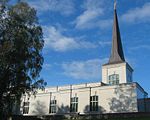Nokia Corporation (natively Nokia Oyj in Finnish and Nokia Abp in Swedish, referred to as Nokia) is a Finnish multinational telecommunications, information technology, and consumer electronics corporation, established in 1865. Nokia's main headquarters are in Espoo, Finland, in the greater Helsinki metropolitan area, but the company's actual roots are in the Tampere region of Pirkanmaa. In 2020, Nokia employed approximately 92,000 people across over 100 countries, did business in more than 130 countries, and reported annual revenues of around €23 billion. Nokia is a public limited company listed on the Helsinki Stock Exchange and New York Stock Exchange. It was the world's 415th-largest company measured by 2016 revenues, according to the Fortune Global 500, having peaked at 85th place in 2009. It is a component of the Euro Stoxx 50 stock market index.The company has operated in various industries over the past 150 years. It was founded as a pulp mill and had long been associated with rubber and cables, but since the 1990s has focused on large-scale telecommunications infrastructure, technology development, and licensing. Nokia made significant contributions to the mobile telephony industry, assisting in the development of the GSM, 3G, and LTE standards. For a decade beginning in 1998, Nokia was the largest worldwide vendor of mobile phones and smartphones. In the later 2000s, however, Nokia suffered from a series of poor management decisions, and soon saw its share of the mobile phone market drop sharply.
After a partnership with Microsoft and Nokia's subsequent market struggles, in 2014 Microsoft bought Nokia's mobile phone business, incorporating it as Microsoft Mobile. After the sale, Nokia began to focus more on its telecommunications infrastructure business and on Internet of things technologies, marked by the divestiture of its Here mapping division and the acquisition of Alcatel-Lucent, including its Bell Labs research organization. The company then also experimented with virtual reality and digital health, the latter through the purchase of Withings. The Nokia brand returned to the mobile and smartphone market in 2016 through a licensing arrangement with HMD Global. Nokia continues to be a major patent licensor for most large mobile phone vendors. As of 2018, Nokia is the world's third-largest network equipment manufacturer.The company was viewed with national pride by Finns, as its mobile phone business made it by far the largest worldwide company and brand from Finland. At its peak in 2000, Nokia accounted for 4% of the country's GDP, 21% of total exports, and 70% of the Helsinki Stock Exchange market capital.










